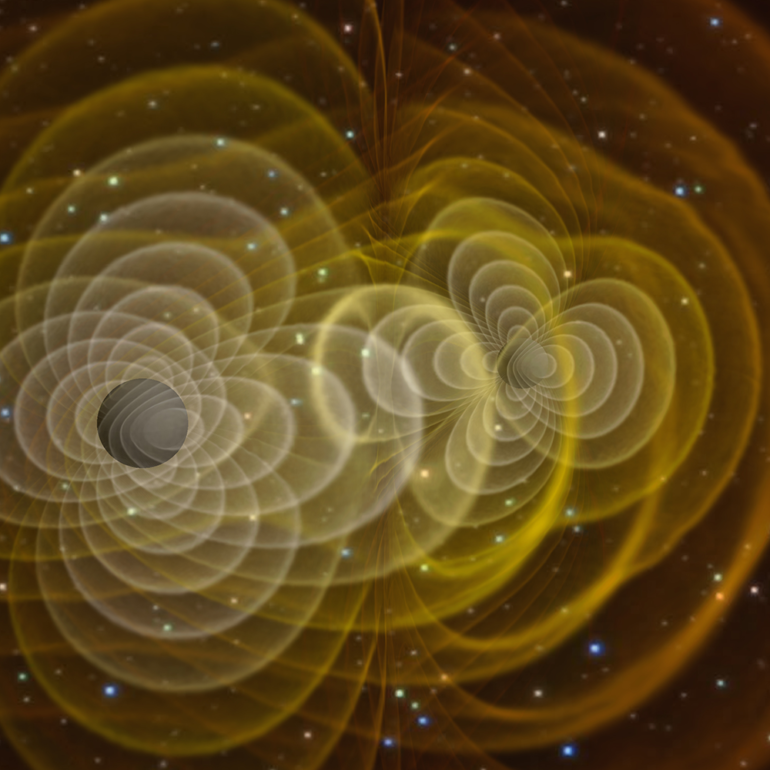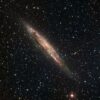Scientists have used a “galaxy-sized” space observatory to find possible hints of a unique signal from gravitational waves, or the powerful ripples that course through the universe and warp the fabric of space and time itself.
The new findings, which appeared recently in The Astrophysical Journal Letters, hail from a U.S. and Canadian project called the North American Nanohertz Observatory for Gravitational Waves (NANOGrav).
For over 13 years, NANOGrav researchers have pored over the light streaming from dozens of pulsars spread throughout the Milky Way Galaxy to try to detect a “gravitational wave background.” That’s what scientists call the steady flux of gravitational radiation that, according to theory, washes over Earth on a constant basis. The team hasn’t yet pinpointed that target, but it’s getting closer than ever before, said Joseph Simon, an astrophysicist at the University of Colorado Boulder and lead author of the new paper.
“We’ve found a strong signal in our dataset,” said Simon, a postdoctoral researcher in the Department of Astrophysical and Planetary Sciences. “But we can’t say yet that this is the gravitational wave background.”
In 2017, scientists on an experiment called the Laser Interferometer Gravitational-Wave Observatory (LIGO) won the Nobel Prize in Physics for the first-ever direct detection of gravitational waves. Those waves were created when two black holes slammed into each other roughly 130 million lightyears from Earth, generating a cosmic shock that spread to our own solar system.
That event was the equivalent of a cymbal crash—a violent and short-lived blast. The gravitational waves that Simon and his colleagues are looking for, in contrast, are more like the steady hum of conversation at a crowded cocktail party.
Detecting that background noise would be a major scientific achievement, opening a new window to the workings of the universe, he added. These waves, for example, could give scientists new tools for studying how the supermassive black holes at the centers of many galaxies merge over time.
“These enticing first hints of a gravitational wave background suggest that supermassive black holes likely do merge and that we are bobbing in a sea of gravitational waves rippling from supermassive black hole mergers in galaxies across the universe,” said Julie Comerford, an associate professor of astrophysical and planetary science at CU Boulder and NANOGrav team member.
Simon will present his team’s results at a virtual press conference on Monday at the 237th meeting of the American Astronomical Society.
Galactic lighthouses
Through their work on NANOGrav, Simon and Comerford are part of a high stakes, albeit collaborative, international race to find the gravitational wave background. Their project joins two others out of Europe and Australia to make up a network called the International Pulsar Timing Array.
Simon said that, at least according to theory, merging galaxies and other cosmological events produce a steady churn of gravitational waves. They’re humungous—a single wave, Simon said, can take years or even longer to pass Earth by. For that reason, no other existing experiments can detect them directly.
“Other observatories search for gravitational waves that are on the order of seconds,” Simon said. “We’re looking for waves that are on the order of years or decades.”
He and his colleagues had to get creative. The NANOGrav team uses telescopes on the ground not to look for gravitational waves but to observe pulsars. These collapsed stars are the lighthouses of the galaxy. They spin at incredibly fast speeds, sending streams of radiation hurtling toward Earth in a blinking pattern that remains mostly unchanged over the eons.
Simon explained that gravitational waves alter the steady pattern of light coming from pulsars, tugging or squeezing the relative distances that these rays travel through space. Scientists, in other words, might be able to spot the gravitational wave background simply by monitoring pulsars for correlated changes in the timing of when they arrive at Earth.
“These pulsars are spinning about as fast as your kitchen blender,” he said. “And we’re looking at deviations in their timing of just a few hundred nanoseconds.”
Something there
To find that subtle signal, the NANOGrav team strives to observe as many pulsars as possible for as long as possible. To date, the group has observed 45 pulsars for at least three years and, in some cases, for well over a decade.
The hard work seems to be paying off. In their latest study, Simon and his colleagues report that they’ve detected a distinct signal in their data: Some common process seems to be affecting the light coming from many of the pulsars.
“We walked through each of the pulsars one by one. I think we were all expecting to find a few that were the screwy ones throwing off our data,” Simon said. “But then we got through them all, and we said, ‘Oh my God, there’s actually something here.'”
The researchers still can’t say for sure what’s causing that signal. They’ll need to add more pulsars to their dataset and observe them for longer periods to determine if it’s actually the gravitational wave background at work.
“Being able to detect the gravitational wave background will be a huge step but that’s really only step one,” he said. “Step two is pinpointing what causes those waves and discovering what they can tell us about the universe.”
To find giant black holes, start with Jupiter
More information:
Astrophysical Journal Letters (2021). DOI: 10.3847/2041-8213/abd401
Provided by
University of Colorado at Boulder
Citation:
‘Galaxy-sized’ observatory sees potential hints of gravitational waves (2021, January 11)
retrieved 11 January 2021
from https://phys.org/news/2021-01-galaxy-sized-observatory-potential-hints-gravitational.html
This document is subject to copyright. Apart from any fair dealing for the purpose of private study or research, no
part may be reproduced without the written permission. The content is provided for information purposes only.



